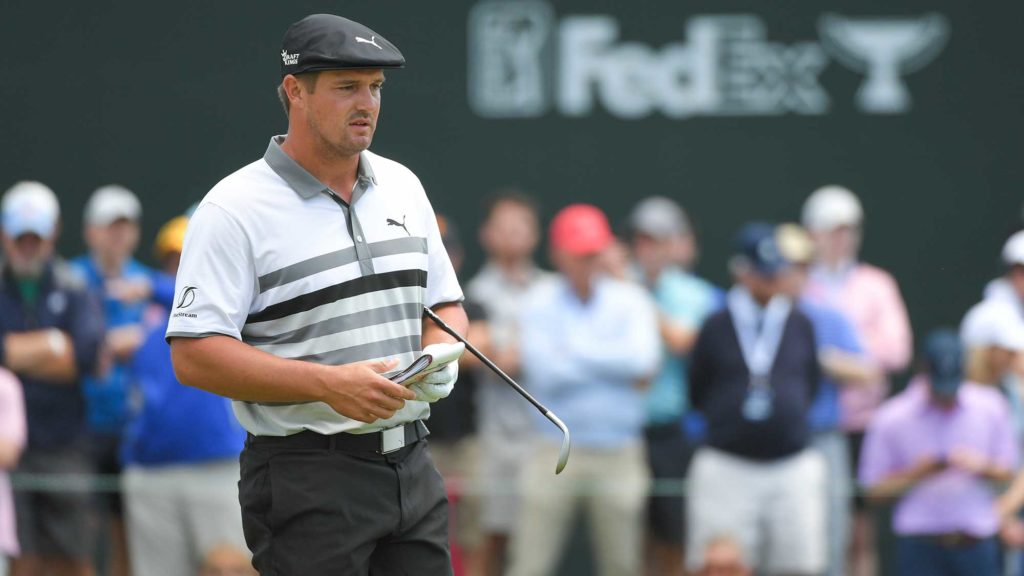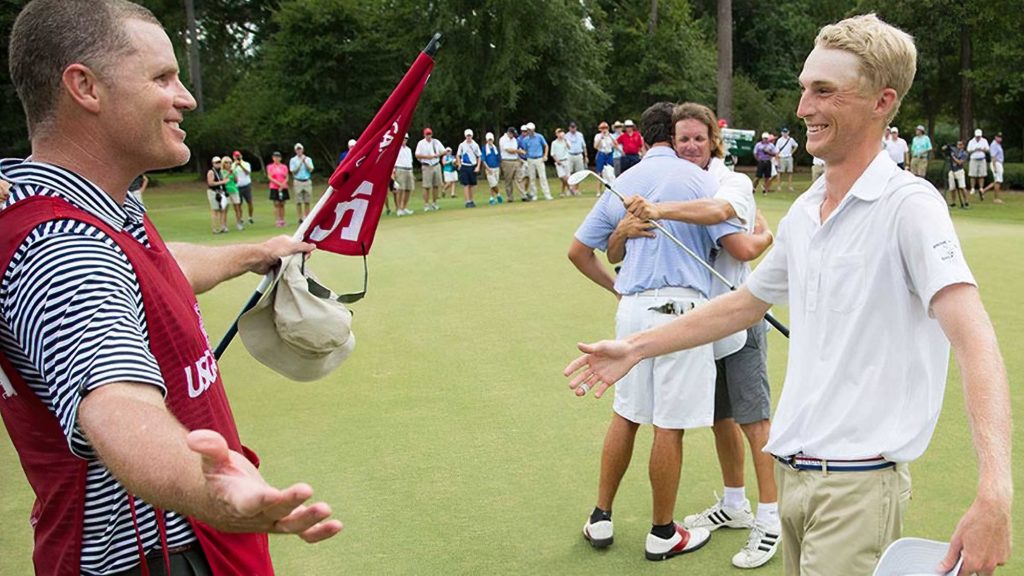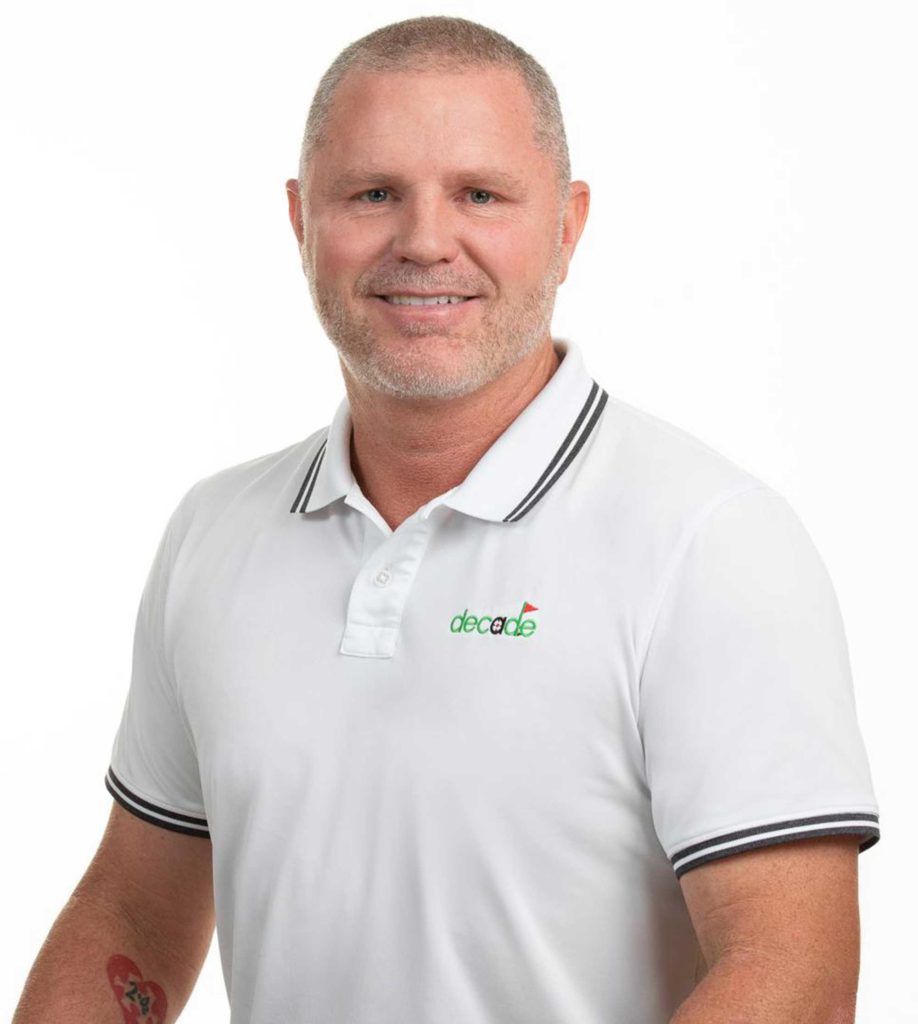Scott Fawcett’s popular DECADE scoring system has possibly made golf easier by turning it into what he calls “a math-based decision problem”. But has he taken the fun out of the game in the process?
In the 13 years since Tiger Woods’ one-legged triumph at Torrey Pines, professional golf has been inundated with information. Walk down a PGA Tour range on a Tuesday and you’ll see nearly every player consulting a launch monitor. Seeing a ball soar through the preferred window is no longer sufficient evidence of a pured shot – the ball speed, launch angle, spin rate and precise carry distance must also check out.
RELATED: Shop for FlightScope Mevo+ Golf Simulator Launch Monitor at The Pro shop
The numbers invasion is not confined to the physical golf shot, either. In 2011, Columbia Business School professor Mark Broadie created the Strokes Gained statistic, a revolutionary tool that measures every golf shot in relative terms. No longer were golf stats limited to bare-bones metrics like greens in regulation or putts per round, which can often be downright misleading; now players – and statisticians – can measure a player’s performance in each part of his game with far greater precision.
At last year’s US Open, Bryson DeChambeau bludgeoned his way to a seismic victory. He hit just 23 of 56 fairways at Winged Foot that week, and the lazy analyst will lament that figure as concrete evidence that golf has lost its soul down the distance rabbit hole. But DeChambeau’s 41-percent fairways-hit ratio was actually better than that week’s field average. Of course, his power keyed the victory, but so did his short-game display, his putting, and a masterful display of course management. For DeChambeau does not think about golf through the old-school prism of fairways hit and greens in regulation, nor does he care about optics – he cares about beating his competitors, and he weaponises maths towards that goal.
He’s been that way for a while. After winning the NCAA individual title in 2015, DeChambeau went out of his way to thank a previously unknown name in the golf ecosystem: “I use a system Scott Fawcett came up with. He’s helped me understand the percentages of going for flags and when not to.”

▶ ▶ ▶
Fawcett wishes he had his system back in his playing days. A self-proclaimed “data nerd”, the 47-year-old Texan gave himself two cracks at professional golf before he saw the writing on the wall. He blames his failure on being a “maniac” who shot himself in the foot with mathematically incorrect decisions. He, and everyone else in the pre-Strokes Gained era, were once blind; now they can see. He believes his course management system has cracked open a game infamous for torturing the mind.
“A coin flip is 50-50 – but if you didn’t know there were only two sides to the coin and you thought there were three, you’d have no idea how to make the correct mathematical bet.” Fawcett says. “But once you know there are only two sides to a coin, it’s very simple to make a bet. And that’s essentially all golf is. It’s really just a math-based decision problem.”
About 30 players in any given PGA Tour field will analyse the course via a packet Fawcett creates, and the vast majority of the field will be at least familiar with his and other stats-guru’s teachings. So who is this Fawcett character? And has he, as he suggests, found a cheat code to golf?
In 2011, Fawcett began posting maths-based course strategy thoughts to the poker forum TwoPlusTwo.com. Later that year, he began combining TrackMan data with newly available Strokes Gained information, all towards a very specific goal.
“I had my amateur status back, and all I wanted to do was win the US Mid-Amateur and play in the Masters,” he said. “That was literally the entire point of doing all this.”
Plans changed in 2014, when he visited a doctor to get a cortisone shot in his bothersome elbow. It went horribly wrong. The shot paralysed his arm for a few days, and he was instructed to put the clubs away for a few months.
About that time, a kid at his local Dallas country club was preparing for the Texas State Amateur.
“I just reached out to him and I said, ‘Dude, I did a lot of math-based course strategy work. You’re a great player, and I don’t really understand why you don’t have better results. At the time, he was ranked No.3,300 in the world in the junior golf standings. So if you just do everything I tell you do to at the state amateur next week, you’ll win.
“He won by three. And I was like, Wow, I didn’t actually believe that. But sure enough, it worked.”
Fawcett caddied for the same kid again a few weeks later, at the US Junior Amateur at Carlton Woods outside Houston, a straight shot down I-45 from Dallas. The kid won again. His name?
“Will Zalatoris sent me a text after I caddied for him saying, ‘You’ve just given me 25 years of experience in five days’,” says Fawcett, beaming like a proud father. “And I’m like, ‘decade’.
I’m going to take decades off your learning curve.”

▶ ▶ ▶
DECADE is Fawcett’s fully fleshed-out offering, the summation of his work in maths-based golf strategy. It’s spreading like wildfire, both on tour and among Average Joes, and it’s actually an acronym: Distance, Expectation, Correct Target, Analyse, Discipline, Execute. We won’t spill too many trade secrets – the “foundations” version of DECADE, an introduction of sorts, costs $US99.99 for a six-month subscription, while the “elite” is $199 for six months – but it’s based on some principles he’s discussed at length.
The first one: golf is hard. Really, really hard.
“What’s sad for all the golfers at home, and you can look yourself in the mirror – we’re all a bunch of Type A obsessive compulsive people. It’s why were attracted to an individual sport where we’re the only ones in control. You don’t have to depend on teammates. Golf is just so set up for failure by attracting perfectionists, and then it really is impossible to perfect.
“And even if you were a robot able to hit the exact same shot over and over again, it’s the largest outdoor sport played with the ball in the air the longest of any sport in the world. The wind, if there’s any wind at all it will make your shot pattern huge… You cannot perfect golf.”
Even the best players in the world don’t know where the ball is going. They simply don’t. It’s becoming less frequent, but you’ll still hear announcers on PGA Tour broadcasts suggest a player should expect to hit it within 10 feet from 100 yards in the fairway. We now have the data to test that hypothesis, and it doesn’t hold up. From 100 yards out in the fairway, on the PGA Tour, just 28 percent of shots end up inside 10 feet. From 162 yards in the fairway, a 9 or 8-iron for most, the average strokes to hole out is 3.0, meaning a guy is equally likely to make bogey and birdie from that position. From 150 yards in the fairway, a wedge for many, more shots end up outside 40 feet than inside 10 feet.
It’s helpful to think of the golf swing as a semi-accurate cannon. The better the player, the more accurate the cannon, but even Tiger Woods at his peak could not tell you exactly where the ball would end up.
“The single most important thing I teach my students is expectation management.”
Admit it: when you play golf, you plan for your best shot. It’s human nature – you remember the good and externalise the bad. You don’t think about the 7-iron you skulled into the water last week, or the one you caught a little fat and went into the bunker three holes ago; you think of the one you flushed to kick-in range, even if it happened last February. This, by the way, is not just a weekend hacker thing.
“At the tour level, everyone plays for the 80th percentile shot, just like all amateurs at home do,” Fawcett says. “When I stand up and tell a tour player to hit a shot – ‘Hey, what’s your 8-iron? 165 yards? Cool. Just go hit a bunch of stock 8-irons and try to hit it 165.’ They will maybe hit 20, 25 percent tops longer than 165. Their average will usually be about 162 or 163. You can mishit shots, but you can’t overpure shots.”
That talk about distance also applies to direction. When choosing a target line, amateurs and pros reflexively think about their best shot, rather than their shot pattern. This term, shot pattern, is a core tenet of DECADE. That 80th percentile shot is part of a shot pattern, but that’s all it is: one data point. And in order to keep the hot pattern as tight as possible, Fawcett implores his players to stick with one shot shape – especially off the tee.
“The double-cross is what makes shot patterns become exponentially larger. OK now, I fade 100 percent of my shots, but now if I’m going to try to hit a draw, I’m going to double cross it literally 25 to 30 percent of the time. That’s just reality. Anyone can go test that at home. That’s really just the way it works. So now, I’m a fader, but I’m trying to draw it, and there’s a decent chance I’m going to start it right and then hit a block cut. Those are always off the planet because you’re working against yourself.”

▶ ▶ ▶
With DECADE, Fawcett has devised a maths-based system that instructs tour players what club to hit and where to aim shots based on cold, hard data. If the strategy had to be summarised in a single sentence: it’s surprisingly aggressive off the tee and surprisingly conservative going into greens. Notice the word “surprisingly” – for as Fawcett will tell you ad nauseum, the lines actually aren’t aggressive or conservative. They’re simply correct. If there are at least 70 yards between areas that would leave a player totally dead – a water hazard, an out-of-bounds, a waist-high clump of cabbage – Fawcett will always instruct his players to hit driver. If there’s less space, consider the width where a 3-wood would finish. If it’s much wider, 3-wood is the play. If it’s not wider – well, as Broadie detailed in his seminal book Every Shot Counts, closer is essentially always better.
But how does a player know if there are 70 yards of space? Back in the day, a player would either need a detailed yardage book to know that information, or walk it off himself. Now, Google Earth has satellite imagery of every golf course that’s accurate to within inches. When he makes packets for players before tour events, he takes images of every hole from Google Earth and diagrams the hole to show how wide landing areas are. He’ll find the centreline of that 70-yard line, and that’s the mathematically optimised target for the hole. It’s that simple.
The par-4 10th at Riviera serves as a telling case study in how the closer-is-better mantra has altered course strategy on the PGA Tour. Jack Nicklaus dubbed it the best short par 4 in golf because of the options it presents. A player can go for the green, but it’s virtually impossible to have a ball actually stay on the putting surface. Miss too far left, and there are trees. Miss right, and good luck holding the green with your second, as it slopes hard from right to left.
The safe play, then, is to hang back with a long iron, stay left to open up the green, nip a wedge and give yourself a look at birdie. Right?
Wrong.
In 2015, just 51 percent of players in the Genesis Invitational went for the green – and they played it in a combined 14-under par. The 49 percent who laid up played it in a combined 52-over par. Fast forward to 2020, and more than 85 percent of players went for the green on the 10th. Think back to what we talked about earlier: no one knows where the ball is going to go. Of course, if you could place a ball in the perfect lay-up spot, 90-odd yards away from the green, that’d be fantastic. But the actual area of turf on the left side of the fairway is… not large.
▶ ▶ ▶
DECADE’s approach-shot system can be loosely summarised as this: avoid short-siding yourself at all costs, for short-siding leads to bogeys. It requires tremendous discipline to avoid flag-hunting and gravitate towards the centre of the green, DECADE-style; the temptation for pros is to try to give yourself a good look at birdie on every hole. Fawcett begs his players to stop trying to make birdies, for the numbers suggest true golf greatness comes from bogey avoidance.
“Birdies happen by accident,” he says. “You’re just waiting for a good string of par 5s and then you’re trying to not give it back on the other holes. That’s really what golf is all about at the end of the day.”
A frequent critique of DECADE is that it’s pointing out obvious information. Pros have been playing to the fat side of the green for, well, decades. Fawcett doesn’t deny this; he frequently cites Tiger Woods as someone who followed DECADE principles almost perfectly without knowing it. In a sense, what Fawcett has done is quantify the hunches of the best course managers.
“Over the years of my career, my gut feeling has been to play a certain way strategically,” Stewart Cink told PGA Tour Radio after his second win last season. “To be aggressive, I kind of know when it’s time. And to be conservative, I know when it’s time. I’ve always managed that part of my game well, it’s been a strength of mine. But I never really had anything to quantify it… Basically what Scott has done is using Strokes Gained, and all the good stats we have available now, he sort of quantified the way my gut has always felt.”
Absent from DECADE is any discussion of golf-course architecture. This is mathematics we’re dealing with, and it has no time to consider such romantic matter as how a course “should” be played.
“The architect’s intention is just totally irrelevant from how I view it,” Fawcett says. “I could not care less about what they think. I mean, it’s a neat idea. I really do mean this, with math and satellites – I do feel bad, they gotta figure out something to design. But there’s just nothing left to guess about.”
With Google Earth, blind shots are no longer blind. With data-driven strategy, “decision” holes like 10 at Riviera are no longer decision holes. You know where you aim, you know what club to hit.
There is, of course, quite a bit of pushback on that notion. Andy Johnson, editor-in-chief of the Fried Egg and an authoritative voice on golf-course architecture, rejects the notion that DECADE and similar programs have solved course architecture.
“I would say that as conditions get firmer at golf courses, and the more prevalent contouring is on greens, around greens, in fairways, the less effective simply examining a golf course by Google Earth is,” Johnson says.
“A golf course is three-dimensional, and Google Earth, by its nature, is two-dimensional. So to say that Google Earth tells the entire story seems a bit – if I showed you something in 2D and then something in 3D, the 3D would look a lot different, and more interesting, and present a different problem.”
Johnson also suggested the very objective of good architecture is to make following programs like DECADE harder.
“Great architecture tries to get you to take the bait. What Scott’s saying is: don’t take the bait. But really great players already know in their head not to take the bait, but they still take the bait every once in a while. They also fool you into not taking the bait, and then you’re in a terrible position. We saw this at [the 2018 US Open at] Shinnecock a ton. Shinnecock turned golfers on their head, because when guys bailed out, it may have looked safe, but sometimes it’s a worse place than where they bailed out from.”

Fawcett initially developed his scoring system in pursuit of his own amateur golf goals. Golf Digest USA
▶ ▶ ▶
On a personal note: as I consumed DECADE content over the past few months, I do feel like I’ve improved as a golfer. But there are downsides.
Unlike Fawcett, I do consider myself something of a golf romantic. Hitting the same shot shape over and over, at a mathematically optimised target, while ignoring the subtleties of the course’s design, is not the game I fell in love with as a kid.
There is, then, a tension between playing golf the way it was intended to be played – the fun way – and playing mathematically optimised golf.
“There is a tiny bit of me that feels bad about that,” Fawcett says. “But the competitive side of me tells that side to shut up and enjoy it.”




